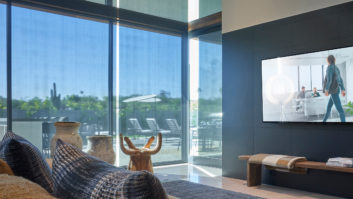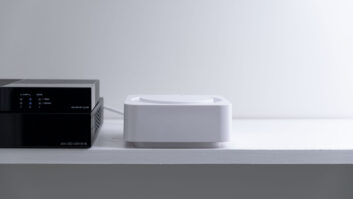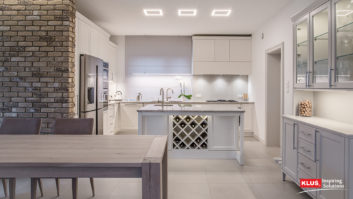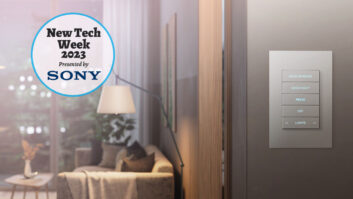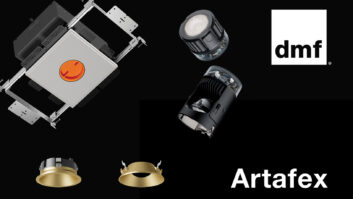How often does a customer call or walk into your showroom specifically interested in buying lights or motorized shades?
Are those crickets we’re hearing?
With big growth potential and dynamic technological development, the lighting and shading control category offers some of today’s most promising products. Despite all the category’s benefits, however, many integrators have failed to realize its potential, which has inspired manufacturers to focus sales initiatives on how dealers can better market their products to customers by communicating an array of financial incentives and lifestyle enhancements.
Somfy is taking the message straight to consumers with various marketing initiatives promoting its interior motorized window coverings. These include its company website, Google Adwords campaigns, social media, and an online video series “highlighting the benefits and lifestyle impacts of motorization,” explained Tracy Christmann, director of marketing, Somfy.

Lutron has helped expand the market with its battery-powered Serena shades, a great solution for retrofits that are very affordably priced, starting from $279. “Another area of focus is with window covering partners in point-of-sale programs, where motorized shades are on display for the consumer to experience at retail locations throughout the country,” Christmann continued. “In 2014, Somfy will be sponsoring NextGenTV’s ‘First to the Future’ online video series with Ty Pennington, host of TV’s Extreme Makeover Home Edition, to further improve market penetration of motorized shades and blinds.”
Somfy also has embraced the “proliferation” of Z-Wave and ZigBee systems, which create a readymade setting for integrating motorized shades. These also help increase visibility with consumers.

Control4 is working closely with motorized shade providers to improve their integration with the Control4 home controller.Lutron has helped expand the market with its battery-powered Serena shades, a great solution for retrofits that are very affordably priced, starting from $279. “This product makes automated shading available to a whole new level of end-users who realize that it’s no longer a luxury, but rather a necessity, for wares like hard-to-reach windows, ensuring privacy, and preventing sun glare,” said Ed Blair, vice president and general manager, Lutron.
The impact of Lutron’s battery-operated shades was also recognized by Ube co-founder and CEO, Utz Baldwin–along with Mode Green’s full solar powered shade on the commercial side of the market, he noted–as “helping to democratize the technology by simplifying the installation and reducing the cost.” Baldwin believes that wireless connectivity is the next progression.
Arming Dealers With the Right Sales Arsenal
Other manufacturers focus on the message dealers are conveying to current and potential clientele. “Conversations about automated lighting and shades are slightly different than what [dealers] are used to, and having the right talking points and tools are key,” said Claudia Barbiero, Crestron marketing solutions manager.
As a result, Crestron has developed several marketing tools for dealers meeting with both homeowners and designers. “These are enduser tools that outline the benefits of light and shade automation, as well as ideas and options to make their home more efficient, comfortable, and increase the value of the investment they are making in their home,” she said.
These include both printed and digital brochures highlighting all the sources of savings these products achieve, as well as their other benefits, such as insulation and managing solar heat gain. Crestron also works to connect dealers to interior designers to get automation into homebuilding at an earlier stage.
AMX takes a direct-to-customer approach, emphasizing how homeowners can save money with an automation investment. “We tell consumers to harvest daylight when it’s available, so the energy savings can offset the cost of motorized shades,” said John Watts, residential sales manager.
Draper employs a similar strategy with its lighting and shade control products. For more discriminating customers, “we are working to educate our network of authorized dealers on the value and functionality of shades, and how they can easily be integrated into their projects,” said Bob Hadsell, home theater sales manager. “We emphasize the importance of managing and harvesting light energy, rather than eliminating it.”
Control4 has found many dealers complaining about complicated integration with third-party shading controllers. “This limits the aggressiveness to which they promote shading solutions,” said Paul Nagel, Control4 VP of lighting and comfort.
“Control4 is focusing on working closely with motorized shade providers to improve the integration between their products and the Control4 home controller,” he said.
LED Leads the Charge
The market’s shining light on the horizon today is undoubtedly LED-based. But with great opportunity also comes unique challenges for integrators.
“Standard lighting approaches are being challenged by entirely new possibilities enabled by LEDs, such as design flexibility, or the ability to dynamically change the color temperature of light,” Crestron’s Barbiero said.
According to Ube’s Baldwin, “LED combines the best features of incandescent and CFLs: low energy, fast response, longer life, and now dimming capabilities.”
Outside forces, like energy regulations and application demands, are driving LED adoption, Baldwin noted. “The level of intelligence we will see in the coming year [and years] is the most impressive.”
Michael Smith, vice president, residential sales, Lutron, said the rate of LED adoption is much quicker than anticipated, and the technology is very different from traditional lighting. “As a result, LED and lighting control manufacturers, like Lutron, face a number of technological challenges relating to their products being used on a home’s lighting circuit, he said. “The challenge is to give people control of LEDs without experiencing common issues, including flicker and pop on/off.”
Lutron has had to re-engineer its dimmers to be compatible with both CFL and LED light bulbs. The result is Lutron’s C·L dimmer collection, phase-adaptive dimmers for the whole-home systems, as well as LED fixtures and drivers for commercial spaces.
For Vantage Controls, “The key issue is the lack of consistency of LED performance,” said Reid Cram, director of marketing communications. “With no standards, and a variety of drivers and control schemes, we have found it necessary to offer a wide platform of control hardware, including forward and reverse phase, 0-10, PWM, etc. Beyond the hardware, we have developed software with the capability of providing custom dimming curves to match a given type of LED. In addition, there is a lack of understanding in the field of the true lamp wattage, so planning for the true load requirement can be a challenge.”
Scott Stephenson, Control4’s senior product manager for lighting and comfort, has observed improvements in the dimming capabilities of LEDs, but he warned of several other issues that integrators should be aware of. Despite dimming advancements, there remains a lack of full-range dimming. “Using a dimmer that can adjust its dimming curve to the dimmable range of the LED makes a huge difference in how smoothly the LED will dim,” he said.

For the lighting system to fully illuminate an art collection and designer spaces, outdated centralized lighting controls at this home were replaced by Osbee Industries with Crestron dimming modules. The existing keypads were replaced with Cameo keypads, and the switches in the remainder of the house were replaced with Cameo wireless in-wall dimmers.
There are both forward and reverse types of dimming that LEDs work differently with. Stephenson recommended adaptive dimmers that can address both these styles.
It’s important to pay attention to wattage ratings for LEDs to determine how many LEDs each dimmer can handle. “If a dimmer doesn’t have a specific wattage rating for LEDs, a good rule of thumb is to multiply the LED wattage by five, and use that number to determine if you’re within the wattage limits of the dimmer,” Stephenson said.
Another difference between traditional incandescent and halogen bulbs is that LEDs maintain color temperature throughout their dimming range. “This can be a desired behavior in a kitchen, home office, or commercial environment; however, in a dining room, bedroom, living room, or home theater, the shift to warmer temperatures in dim light creates an important part of the ambience,” Stephenson said. “While not common yet, a few LED bulbs have started to appear on the market that attempt to mimic the color temperature shift of incandescents during dimming.”
The Silver Lining of DIY Solutions
In today’s world of disruptive startup tech firms, there’s a natural influx of inexpensive, DIY, massmarket solutions for a fraction of the price of custom options. On the surface, the concept seems threatening to the way this industry does business, but manufacturers generally see these solutions as promoting familiarity with the extensive home automation capabilities available to make consumers’ lives easier and more enjoyable.
“We consider any mass market control solution to be a benefit to the automation industry by increasing overall market awareness of the benefits of control,” AMX’s Watts said.
Some lighting control manufacturers are beginning to produce opportunities from the benefits of these newer, low budget products. Control4’s partner Extra Vegetables has created a driver tying the Philips Hue LED lights into the Control4 system.
Just recently, Savant Systems announced support for Philips Hue lighting in its latest control platform iteration. A Philips Hue communication protocol is now native to the Savant platform with no need for third-party drivers or accessories for interoperability. Savant’s RacePoint Blueprint configuration tool allows integrators to control an unlimited quantity of Hue bulbs at the same time, as well as the ability to program scenes and manually adjust colors.
Demand for Hue functionality originated from Savant’s growing base of retailers, like Bang & Olufsen and Apple Authorized Resellers. “One advantage of using Hue with Savant is the ability to mix Hue bulbs into an automated environment and/or lighting control system featuring lighting products and technologies from a host of manufacturers,” said Jim Carroll, executive vice president, corporate strategy and business development. “With the Hue app, users can only control Hue bulbs.”
Ube’s Baldwin suggested that mass-market solutions like Hue were designed for mass adoption. “I will be the first to admit that the Ube smart WiFi Dimmer was not intended to be installed into a 20,000-square-foot home, but it was designed to disrupt the market,” he said. “Our dimmer does not require additional hardware; they communicate with each other, measure your energy usage in real time, and cost less. We believe more consumers will adopt lighting control because of this.”
Lindsey Adler is associate editor of Residential Systems, Systems Contractor News, and Healthcare AV.

